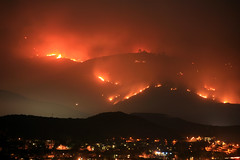 Image via Wikipedia
Image via Wikipedia
Climate Progress
From the University of Alaska, Fairbanks:
‘A team led by International Arctic Research Center scientist Igor Semiletov has found data to suggest that the carbon pool beneath the Arctic Ocean is leaking.
The results of more than 1,000 measurements of dissolved methane in the surface water from the East Siberian Arctic Shelf this summer as part of the International Siberian Shelf Study show an increased level of methane in the area. Geophysical measurements showed methane bubbles coming out of chimneys on the seafloor.
“The concentrations of the methane were the highest ever measured in the summertime in the Arctic Ocean,” Semiletov said. “We have found methane bubble clouds above the gas-charged sediment and above the chimneys going through the sediment.”
The new data indicates the underwater permafrost is thawing and therefore releasing methane. Permafrost can affect methane release in two ways. Both underwater and on land, it contains frozen organic material such as dead plants and animals. When permafrost thaws, that organic material decomposes, releasing gases like methane and carbon dioxide. In addition, methane, either in gas form or in ice-like methane hydrates, is trapped underneath the permafrost. When the permafrost thaws, the trapped methane can seep out through the thawed soil. Methane, a greenhouse gas 20 times more powerful than carbon dioxide, is thought to be an important factor in global climate change.
The East Siberian Arctic Shelf is a relatively shallow continental shelf that stretches more than 900 miles into the Arctic Ocean from Siberia. The area is a year-round source of methane to the globe’s atmosphere. However, until recently, scientists believed that much of the area’s carbon pool was safely insulated by underwater permafrost, which is, on average, 11 degrees Celcius warmer than surface permafrost.’
From ClimateProgress:
These observations are extremely worrisome for four reasons. First, many fear that a huge methane release is what happened during the Permian-Triassic extinction event and the Paleocene-Eocene Thermal Maximum. Second, releasing even a small fraction of the sub-sea methane would make a stabilizing greenhouse gas emissions at non-catastrophic concentrations all but impossible.
Third, as NOAA reported earlier this year, levels of methane rose sharply last year for the first time since 1998…
Fourth, the findings are apparently based on very new and credible in situ measurements: “Semiletov said this year’s expeditions used both chemical and geophysical measurement techniques, a first in the area.”
From the original announcement published in the the online British journal, TheIndependent:
The first evidence that millions of tons of a greenhouse gas 20 times more potent than carbon dioxide is being released into the atmosphere from beneath the Arctic seabed has been discovered by scientists.
The Independent has been passed details of preliminary findings suggesting that massive deposits of sub-sea methane are bubbling to the surface as the Arctic region becomes warmer and its ice retreats.
Underground stores of methane are important because scientists believe their sudden release has in the past been responsible for rapid increases in global temperatures, dramatic changes to the climate, and even the mass extinction of species. Scientists aboard a research ship that has sailed the entire length of Russia’s northern coast have discovered intense concentrations of methane – sometimes at up to 100 times background levels – over several areas covering thousands of square miles of the Siberian continental shelf.
In the past few days, the researchers have seen areas of sea foaming with gas bubbling up through “methane chimneys” rising from the sea floor. They believe that the sub-sea layer of permafrost, which has acted like a “lid” to prevent the gas from escaping, has melted away to allow methane to rise from underground deposits formed before the last ice age.
…
The amount of methane stored beneath the Arctic is calculated to be greater than the total amount of carbon locked up in global coal reserves so there is intense interest in the stability of these deposits as the region warms at a faster rate than other places on earth.(ed: more than 7 degrees F in the past several decades.)
Orjan Gustafsson of Stockholm University in Sweden, one of the leaders of the expedition, described the scale of the methane emissions in an email exchange sent from the Russian research ship Jacob Smirnitskyi.
“We had a hectic finishing of the sampling programme yesterday and this past night,” said Dr Gustafsson. “An extensive area of intense methane release was found. At earlier sites we had found elevated levels of dissolved methane. Yesterday, for the first time, we documented a field where the release was so intense that the methane did not have time to dissolve into the seawater but was rising as methane bubbles to the sea surface. These ‘methane chimneys’ were documented on echo sounder and with seismic [instruments].”
At some locations, methane concentrations reached 100 times background levels. These anomalies have been seen in the East Siberian Sea and the Laptev Sea, covering several tens of thousands of square kilometres, amounting to millions of tons of methane, said Dr Gustafsson. “This may be of the same magnitude as presently estimated from the global ocean,” he said. “Nobody knows how many more such areas exist on the extensive East Siberian continental shelves.
“The conventional thought has been that the permafrost ‘lid’ on the sub-sea sediments on the Siberian shelf should cap and hold the massive reservoirs of shallow methane deposits in place. The growing evidence for release of methane in this inaccessible region may suggest that the permafrost lid is starting to get perforated and thus leak methane… The permafrost now has small holes. We have found elevated levels of methane above the water surface and even more in the water just below. It is obvious that the source is the seabed.”
and a related story from TheIndependent:
The rapid rise in greenhouse gases over the past century is unprecedented in at least 800,000 years, according to a study of the oldest Antarctic ice core which highlights the reality of climate change.
Air bubbles trapped in ice for hundreds of thousands of years have revealed that humans are changing the composition of the atmosphere in a manner that has no known natural parallel.
Scientists at the British Antarctic Survey (BAS) in Cambridge have found there have been eight cycles of atmospheric change in the past 800,000 years when carbon dioxide and methane have risen to peak levels.
Each time, the world also experienced the relatively high temperatures associated with warm, inter-glacial periods, which were almost certainly linked with levels of carbon dioxide and possibly methane in the atmosphere.
However, existing levels of carbon dioxide and methane are far higher than anything seen during these earlier warm periods, said Eric Wolff of the BAS.
“Ice cores reveal the Earth’s natural climate rhythm over the last 800,000 years. When carbon dioxide changed there was always an accompanying climate change,” Dr Wolff said. “Over the past 200 years, human activity has increased carbon dioxide to well outside the natural range and we have no analogue for what will happen next.
I usually don’t quote me but here it is anyway, from the post titled ‘Arctic Methane’:
Remember a few months ago Wordout reported that scientists had discovered evidence in ice cores which showed that in the past, drastic changes in climate have occurred in as little as one or two years? One of the tipping points appears to be the release of massive amounts of methane into the atmosphere.
This year is the 1st in the history of Man that the arctic sea ice has melted enough to open shipping routes through the Arctic ocean.
We all need to wake up to the real catastrophe brewing right under our noses. If you think the financial meltdown is bad, just wait ’til the climate meltdown gets your undivided attention.
I am Jon. Time to wake up and smell the methane, folks.





http://www.latimes.com/news/science/environment/la-na-global-warming-methane22-2009feb22,0,6678890.story
is a story you might like
Thank you George. You were right. I’m going to include a short 2 minute video from the article you linked in the LATimes, showing some of that arctic methane burning.
In the middle of an ice field.
I highly recommend the article.